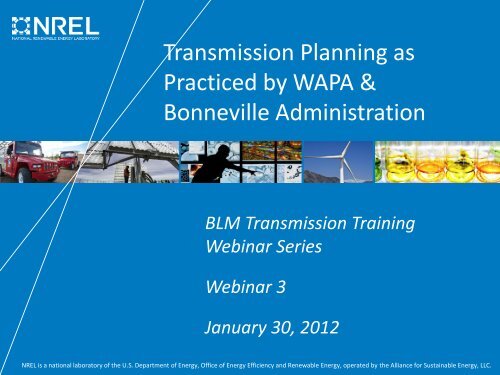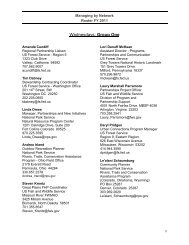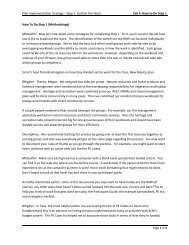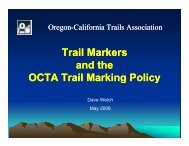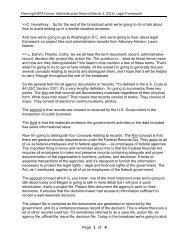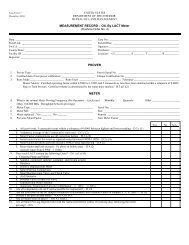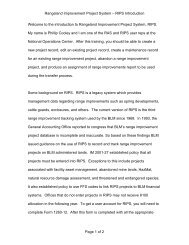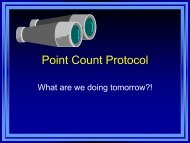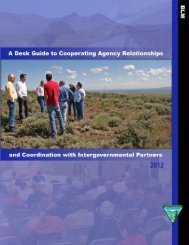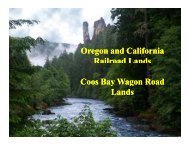Presentation 3 - National Training Center
Presentation 3 - National Training Center
Presentation 3 - National Training Center
Create successful ePaper yourself
Turn your PDF publications into a flip-book with our unique Google optimized e-Paper software.
AGENDAJanuary 30, 2013• NERC/FERC• WAPA Annual Planning Process• Line Separation• TOT3 Example• Questions4
• NERC/FERC6
Electric Industry Recent Rulings• Energy Policy Act of 1992• Orders 888/889 – SeparateGen/Transmission; OASIS Postings• Energy Policy Act of 2005• FERC – Authority to Manage the ERO(NERC) who in-turn manages the RROs(WECC, MRO, SPP)• Order 890 – Open StakeholderInvolvement7
Electric Industry Recent Rulings• American Recovery and Reinvestment Actof 2009• Order 1000 – More Inclusive PlanningProcess; Cost/Benefit Analysis; CostAllocation on both Intra- and Inter-Regional Basis8
WestConnectSubregional Planning GroupsCCPG, SSPG and SWAT aretechnical planning work groupswithin the WestConnect Footprint• Coordinate Information for useby all study participants• Define subregional study plans,provide study resources, andperform studies• Provide forum for coordinationand peer review of planningstudies and 10-year plans• Agree on inter- and intra-Regional Projects and have a CostAllocation processSSPGSierra SubregionalPlanning GroupSWATSouthwestAreaTransmissionCCPGColoradoCoordinatedPlanningGroup11
NERC Planning Standards - TPLTen YearSeasonalCasesNERCCategoryANERCCategoryBAnalyzeAgainstCriteria• Bus Voltages• Change inBus Voltages• Power FlowResultsNERCCategoryC12
• WAPA 10-Yr TransmissionStudy Timeline13
Study TimelineFebruary 1March 15March 15 –June 15July 31July 31 –November 30November 30• Send 10YR loadforecast requestto all networkcustomers• Requestsubmittal byMarch 15• 10YR loadrequestresponses due.• Conduct annualstudy• Annual reportdue to J5640• J5640 developspreliminaryproject scope andbudgetaryestimates forinclusion in CIP• J5640 toincorporateprojects into theCIP (10YR PlanReport)Load Forecast Data Example14
Study ProcessRMR North Case ModificationsStressNo Stress•TOT3 1739 MW•TOT5 874 MW•YTS 628 MW2015 HA2017-22•Loads modifiedwithouttopologychanges2012StudyStressStress•TOT3 1692 MW•TOT5 1056 MW•YTS 618 MW2017 HS2022 LS•TOT3 1710 MW•TOT5 642 MW•YTS 626 MW15
RMR North RecommendationsBasin-NahneJensen 115kV LineRecondPoncha 30MVARReactorSidney230/115kVXfmr JointStudyBig HornBasinSensitivityStudy$2,500,000106% load ofnorm/emerg.rating during YT-YTPACE N-1.Case History:2015-2016-20172009-part of YTSTransfer Project2010-Removed2012-confirmedN-1 thermal issuesensitivity studymay alter scope.$500,000230 kV systemhistory of highvoltage duringlight loading;studies@ 1.067pu. Project maybe provided byPSCO.Case History:2015-2017-2022Loss of TSGT‘sSidney 230/115kV transformerresults in 6-10%voltage deviationon area 115 kVsystem;Joint study withTSGTrecommended.Case History:2015-2016-201769 and 115 kVreactive supportneeded; thermaloverload on 115kV system.Sensitivity studyto determinelong term, lowcost solution forthe Big HornBasin Area.Case History:2015-2016-201716
Capacity Adequacy Analysis• Performed by the TransmissionBusiness Unit• Incorporated into the Ten Year Study asa means to identify transmissioncapacity issues that impede thecommercial viability and efficientoperation of the Western TransmissionNetwork17
CAA Results• Several Significant Path ConstraintsIdentified including:- Craig-Bonanza (CRCM)- Dave Johnston-Ault (LAPT)- Four Corners area from theSouth (Southern CRSP)- Paths into CA from AZ18
• Line Separation19
Typical 500-kV Transmission Structure20
“Minimalist” Separation Distance21
“Span-Length” Separation22
No “One-Size Fits All”• Reliability Perspective – Further Apart toMinimize Possible Simultaneous Outages• Further Apart – Land Use/Environmental• Public/Stakeholder Input• State/Regional/<strong>National</strong> Interests23
No “One-Size Fits All”• Redundancy Leads to more StableNetwork• One-Span Length Cuts down theProbability of a Wire being Swung fromOne Circuit to the Other• Terrain – Mountainous vs. Farmland• NEW WECC Business Practice - Need250’ Separation to Consider Separate forFault Simulations24
• TOT3 Example25
PRINCE RUPERTPEACE CANYONSUNDANCEWECC Constrained PathsMICALANGDONLANGDON3SEATTLEAREAVANCOUVERAREACHIEF JOSEPH8HOT SPRINGSFT. PECKCANADAUNITED STATESPORTLANDAREABUCKLEY14HELLSCANYONCOLSTRIPBURNSBOISE1866SHASTAMALINROUND MTN65MIDPOINT172019TABLE MTNSALT LAKECITY AREA3036DENVERAREASAN FRANCISCOAREALOS ANGELESAREALUGO4546DEVERS35MOJAVEHOOVER49PHOENIXAREA5134PINTO50NAVAJO2223FOURCORNERS48484731ALBUQUERQUEAREAEL PASOAREAMEXICOTransmission Paths26
TOT-3 TTC/ATC CalculationsTOT3 Ownership CapacityMBPP – 70.5% 1132Western – 24.93% 475T. State – 0.83% 13PSCo – 3.74% 60168028
345KV230KV115KVGTOT3 MAJOR LINESLRSSTEGALL400 MW700 MWSIDNEYTOT3ARCHERWYOMINGNEBRASKACOLORADOAULTSTORYN.YUMAG PAWNEE29
345KV230KV115KVGTOT3 MAJOR LINESLRSSTEGALL0 MWLOADs to100%OUTAGE!1000 MWSIDNEYTOT3ARCHERWYOMINGNEBRASKALOW VOLTAGECOLORADOAULTSTORYN.YUMAG PAWNEE30
345KV230KV115KVOVERLOADGTOT3 MAJOR LINESLRSSTEGALL450 MW200 MW injection W850 MWSIDNEYTOT3ARCHERWYOMINGNEBRASKACOLORADOAULTSTORYN.YUMAG PAWNEE31
345KV230KV115KVGTOT3 MAJOR LINESLRSSTEGALL0 MWOVERLOAD/INSTABILITYOUTAGE!1200 MWSIDNEYTOT3ARCHERWYOMINGNEBRASKALOW VOLTAGECOLORADOAULTSTORYN.YUMAG PAWNEE32
August 14, 2003
QUESTIONS?34
Western Area Power AdministrationTransmission Infrastructure ProgramPresented to: BLM Webinar35
TIP PROGRAM OVERVIEWImplement Title III Hoover Power Plant Act 1984(under American Recovery and Reinvestment Act)Borrowing authority of $3.25 billionIdentify, prioritize and participate in the study, facilitation,financing, planning, operating, maintaining, and construction ofnew or upgraded transmission facilities36
TIP MILESTONES• Feb 2009: Western receives TIP borrowing authority from congress• March 2009: Western published a “Notice of Availability of Request for Interest”in Federal Register• April 2009: Western chartered a Sr Mgt and Transmission Planning team toevaluate over 200 statements of interest from potential project sponsors.• Oct 2009: TIP names Program Manager and begins staffing• TIP is transitioning from start up phase to permanent phase• TIP remains open to new solicitations from Project developers.37
TIP FutureTIP OptimizationBased on Continuous Improvement• Evaluate the Program project development process• Evaluate existing criteria for screening and prioritizing potentialProgram projects• Increase the transparency of the vetting process for potentialProgram projects and• Improve communications with Program applicants38
TIP PROGRAM PRINCIPLES• Projects must have one terminus within area served by Western• Deliver, or facilitate the delivery of, power generated by renewable energyresources to be constructed or reasonably expected to be constructed• Encourage broad-based participation• Uses Project revenue as the only source of revenue for:ooRepayment of loan for projectPayment of ancillary service and O&M expenses• Maintain controls for accounting and repayment - projects under this authorityare separate and distinct• Ensure project beneficiaries repay project cost• Must be in the Public Interest• Must not impair system reliability or statutory obligations• Have reasonable expectation of repayment of principal and interest of Treasuryloan and associated project costs on a stand alone basis – costs cannot beintegrated into existing projects• Use a public process to set rates for new facilities• Must independently obtain and arrange for the delivery of generation-relatedancillary services39
PROJECT SELECTION CRITERIAProjects under consideration for TIP funding must:• Facilitate the delivery to market of power generated by renewable resourcesconstructed or reasonably expected to be constructed.• Have at least one terminus located within Western’s service territory.In addition, project evaluation includes feasibility of developing a project that meets thefollowing criteria:• Provides economic developmental benefits, including an estimate of how many,the type, how fast, and where in the country jobs are created.• Gives priority to projects that satisfy Western’s Open Access Transmission Tariff(OATT) or related requests.• Addresses the technical merits and feasibility of a project.• Financial stability and capability of all potential project partners.• Project readiness (e.g., permitting, local, state and/or regional approval).• Project partners’ participation in a region-wide interconnection-wide planninggroup or forum.40
TIP PROJECT MODELS• Financier model• Construction financing• Construction – Long-term financing• Western owns capacity• Example Project – Montana Alberta Tie Limited (MATL)• Public-Private Partnership model• Partnership with Merchant Transmission Developer• Western uses borrowing authority to finance ownership in Project• Example Project - TransWest Express Transmission Project (TWE)• Western internal transmission projects• Partnership with Western Regional office to add or upgrade neededtransmission identified typically through 10-year planning process.• Example Project - Electrical District 5-Palo Verde Hub Project (ED5-PVH)41
NEGOTIATING WITH DEVELOPERS• Upon selection of SOI, Project Developers favoring Advanced FundingAgreements.• TIP brings the following to the transaction:• Siting, Scoping and Permitting expertise for Environmental processapprovals• WECC path rating expertise in terms of managing studies and process• Experience with Interconnection Agreements• Design expertise for transmission lines and sub-stations• Construction management and Quality Assurance for EPC• Financial structuring and project financing• Operations and maintenance capability• TIP Borrowing authority• Experience with Regulatory issues42
EXAMPLE OF TRANSACTION STRUCTUREOther InvestorsFinance Agreement(s)Project DeveloperJoint Ownership AgreementWestern AreaPowerAdministrationEPC & O&M ContractsTIP BorrowingAuthorityPrivate LendingFacilityProjectSpecial PurposeVehicle LLCWAPAEPCO&MTSR forTransmissioncapacityPPA for GenerationCapacity43
UNDERWRITING REQUIREMENTS• A solid business plan and Project operating plan• Financing and commercially-sound project producing adequate cash-flow to:• Pay all operational costs• Service all debt• Provide owners with reasonable rate of return• Track record of success on similar projects44
WESTERN CERTIFICATIONFinally, Western’s Administrator must certify, prior to borrowing funds fromTreasury, that each project:• Public interest nexus• No adverse impact to system reliability or operations, or other statutoryobligations.• Reasonable expectation that the project will generate enoughtransmission service revenue to repay the principal investment; alloperating costs, including overhead; and the accrued interest by theend of the project’s service life.45
Western ContactsCraig Knoell, TIP ManagerE-mail: knoell@wapa.govPhone: 720-962-7710Kaicheng Chen, System PlanningEngineerE-mail: chen@wapa.govPhone: 720-962-771346
Overview of TransmissionPlanningAnders JohnsonBonneville Power AdministrationLong Term Planning47
Basics of Electric Transmission• Alternating Current (AC) vs.Direct Current (DC)• Generation and load mustalways be balanced• Higher voltages used to movepower long distances• AC flows are closelymonitored but difficult toprecisely controlGeneratorTransformerSubstationTransmissionLineSubstationTransformerLoad48
Drivers for New Transmission• Load Growth• New generators– Renewables– Dispatchable capacity• Changes in asset utilization– Generator retirements (High emission coal)– Oversupply in some areas vs. shortages in others• Open Access Transmission Tariff (OATT)requests49
Transmission Planning Considerations• NERC/WECC Transmission Planning Standards– Deterministic: System must withstand all crediblesingle and common mode contingencies withoutviolating performance requirements– Thermal overload, voltage stability, transient stability• Integrated Resource Planning– Probabilistic: Must have enough transmission capacityto deliver generation to reduce loss of load probability– Production cost analysis– Transmission congestion increases cost to customers50
PExample: Line OutageBeforeAfterGenerator PTransformerSubstation½ P½ PTransmissionLinesPSubstationPTransformerPLoad51
Capacity Increase Options• Incremental upgrades: Push more power throughexisting lines– Substation equipment (capacitors, transformers,circuit breakers)– Increased line rating (increase clearance to ground,replace conductor– Control actions• Build a new line– Sometimes the only technically feasible option– Rebuild existing line to higher capacity, build next toexisting corridor, or build in new corridor– Lumpy52
Additional Considerations• Is project feasible to permit?• Available Transfer Capacity– Commercial allocation of capacity– Firm vs. Non-firm– Need capacity all the way from generation to load, notjust across monitored elements of a path• “Too Big to Fail” Problem– Must plan for outages of double circuit, adjacentcircuit, and HVDC lines– Double circuit does not always provide double theusable transfer capacity as single circuit53
Questions?54
Kim Berns, Division ChiefDivision of Lands, Realty & Cadastral SurveyBLM – Washington Officekmberns@blm.gov202-912-7350Lucas Lucero, Rights-of-Way Branch ChiefBLM - Washington Officellucero@blm.gov202-912-7342Beth Ransel, Linear ROW/Master AgreementsProgram LeadBLM – Washington Officebransel@blm.gov202-912-7213


